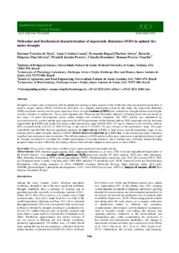Molecular and biochemical characterization of superoxide dismutase (SOD) in upland rice under drought.
Molecular and biochemical characterization of superoxide dismutase (SOD) in upland rice under drought.
Autoria: DEUS, K. E. de; LANNA, A. C.; ABREU, F. R. M.; SILVEIRA, R. D. D.; PEREIRA, W. J.; BRONDANI, C.; VIANELLO, R. P.
Resumo: Drought is a major cause of reduced yield in upland rice farming in many regions of the world and cause an increased production of reactive oxygen species (ROS), followed by activation of a complex antioxidant system. In this study, the superoxide dismutase (SOD) enzymatic activity and the gene expression levels of eight isoforms of SOD were evaluated in drought-tolerant and drought-sensitive varieties of upland rice, Oryza sativa japonica (the Primavera and Douradão cultivars), including shoot and root tissues in two stages of plant development, grown under normal and restricted irrigation. The SOD activity was determined by spectrophotometric method and the gene expression by qPCR experiments. In the tolerant cultivar, SOD enzymatic activity increased significantly (p ≤ 0.05) only in the root tissue in the reproductive stage (268.00 SOD UN mg-1), whereas in the sensitive cultivar, SOD increased in the leaf (112.17 SOD UN mg-1) and root (172.56 SOD UN mg-1) tissues in the reproductive stage. The genes CuZnSOD4 and MnSOD showed significant increases in expression (p ≤ 0.05) in both tissues and developmental stages in the tolerant cultivar under drought, whereas FeSOD1 showed increased expression (p ≤ 0.05) only in the tolerant genotype (vegetative stage/leaf and root) under water restriction. The different patterns of SOD activity and/or gene expression in upland rice plants should be strongly considered to elucidate the cellular mechanisms of drought tolerance; these findings may ultimately inform breeding programs aimed at more efficiently developing cultivars that are better adapted to areas prone to water deficits.
Ano de publicação: 2015
Tipo de publicação: Artigo de periódico
Unidade: Embrapa Arroz e Feijão
Palavras-chave: Arroz, Enzymatic activity, Gene expression, Oryza sativa, Oxidative stress, Resistencia a seca, Rice, Superoxide dismutase, Water stress
Observações
1 - Por padrão são exibidas publicações dos últimos 20 anos. Para encontrar publicações mais antigas, configure o filtro ano de publicação, colocando o ano a partir do qual você deseja encontrar publicações. O filtro está na coluna da esquerda na busca acima.
2 - Para ler algumas publicações da Embrapa (apenas as que estão em formato ePub), é necessário ter, no celular ou computador, um desses softwares gratuitos. Sistemas Android: Google Play Livros; IOS: iBooks; Windows e Linux: software Calibre.
Acesse outras publicações
Acesse a Base de Dados da Pesquisa Agropecuária (BDPA) para consultar o acervo completo das bibliotecas da Embrapa.

